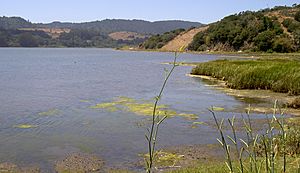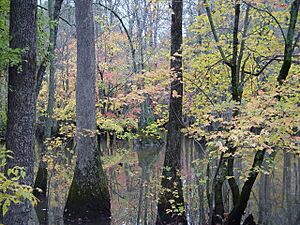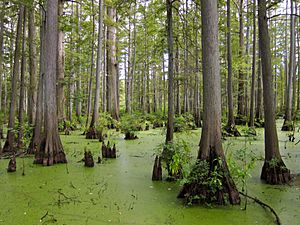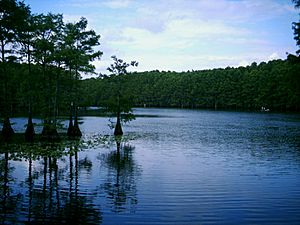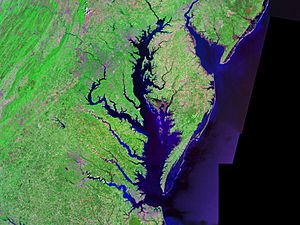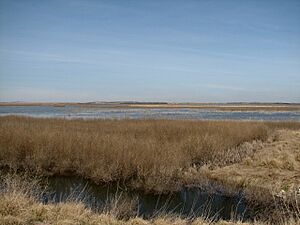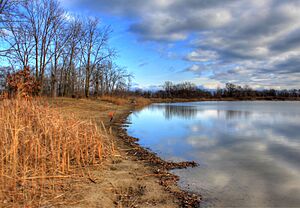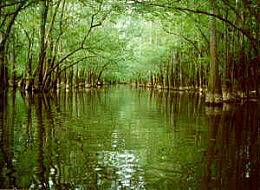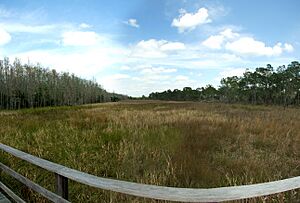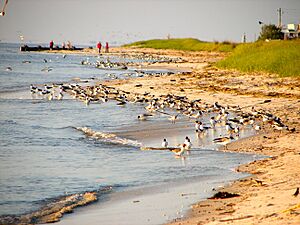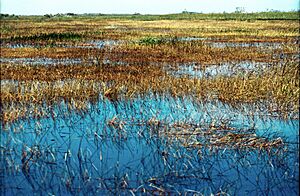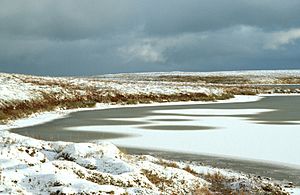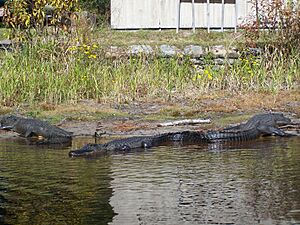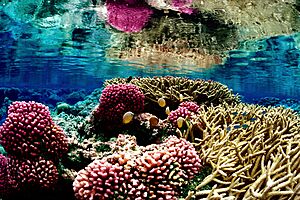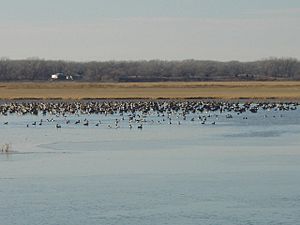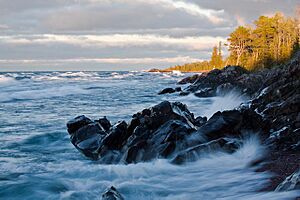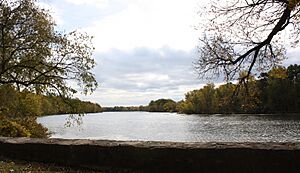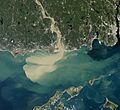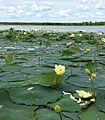List of Ramsar sites in the United States facts for kids
The Ramsar Convention is a special international agreement that helps protect important wetlands around the world. Wetlands are places where water covers the land, like swamps, marshes, and bogs. They are super important because they provide homes for many plants and animals, help clean our water, and protect us from floods.
As of 2020, the United States has 41 special wetlands called "Ramsar Sites." These sites cover a huge area, about 1,884,551 hectares (or 7,276 square miles). This list tells you about some of these amazing places in the U.S.
Contents
- What are Ramsar Sites?
- Amazing Wetlands Across the U.S.
- Ash Meadows National Wildlife Refuge
- Bolinas Lagoon
- Cache-Lower White Rivers
- Cache River-Cypress Creek Wetlands
- Caddo Lake
- Chesapeake Bay Estuarine Complex
- Cheyenne Bottoms
- Chiwaukee Illinois Beach Lake Plain
- Congaree National Park
- Corkscrew Swamp Sanctuary
- Delaware Bay Estuary
- Everglades National Park
- Izembek Lagoon National Wildlife Refuge
- Okefenokee National Wildlife Refuge
- Palmyra Atoll National Wildlife Refuge
- Quivira National Wildlife Refuge
- San Francisco Bay and Estuary
- Upper Mississippi River Floodplain Wetlands
- Images for kids
- See also
What are Ramsar Sites?
The Ramsar Convention was signed in 1971 in Ramsar, Iran. It's an agreement between many countries to protect and wisely use wetlands. When a wetland is named a Ramsar Site, it means it's considered very important for nature and people. These sites are often home to rare animals or plants, or they are vital resting spots for migratory birds.
Amazing Wetlands Across the U.S.
The United States is home to many diverse and important Ramsar sites. Each one has unique features and plays a special role in its ecosystem. Here are a few examples:
Ash Meadows National Wildlife Refuge
- Location: Nevada
- Designated: December 18, 1986
This refuge is a desert oasis with many springs and wetlands. It's home to at least 26 types of plants and animals found nowhere else in the world! It's a critical place for protecting unique desert life.
Bolinas Lagoon
- Location: California
- Designated: September 1, 1998
Bolinas Lagoon is a tidal estuary (where a river meets the sea) on the Pacific Flyway. This means it's a crucial stop for thousands of migratory birds traveling along the coast. It provides a safe home for ducks, geese, and many kinds of shorebirds.
Cache-Lower White Rivers
- Location: Arkansas
- Designated: November 21, 1989
This area includes parts of the Cache River and Lower White River National Wildlife Refuges. It's known for its vast bottomland hardwood forests and wetlands, which are important for many species, including migratory waterfowl.
Cache River-Cypress Creek Wetlands
- Location: Illinois
- Designated: November 1, 1994
This wetland complex in southern Illinois features ancient bald cypress and tupelo trees. Some of these trees are over 1,000 years old! It's a beautiful and important habitat for many animals.
Caddo Lake
Caddo Lake is a unique lake and wetland system known for its stunning bald cypress trees draped with Spanish moss. It's a maze of bayous, sloughs, and ponds, providing a rich habitat for fish, alligators, and birds.
Chesapeake Bay Estuarine Complex
The Chesapeake Bay is the largest estuary in the United States. This Ramsar site protects a part of this huge bay, which is incredibly important for seafood, migratory birds, and water quality for millions of people.
Cheyenne Bottoms
- Location: Kansas
- Designated: October 19, 1988
Cheyenne Bottoms is the largest inland marsh in the United States. It's a critical stopover point for millions of migratory shorebirds and waterfowl on the Central Flyway, making it a birdwatcher's paradise.
Chiwaukee Illinois Beach Lake Plain
This special area stretches across two states along the shore of Lake Michigan. It includes rare coastal habitats like sand dunes, prairies, and wetlands. It's a great example of how different natural areas can connect.
Congaree National Park
- Location: South Carolina
- Designated: February 2, 2012
Congaree National Park protects the largest remaining old-growth bottomland hardwood forest in the southeastern U.S. It's famous for its towering trees and a rich floodplain ecosystem that floods regularly, supporting diverse wildlife.
Corkscrew Swamp Sanctuary
- Location: Florida
- Designated: March 23, 2009
This sanctuary in Florida is home to the largest remaining old-growth bald cypress forest in North America. It's a vital habitat for many wading birds, alligators, and the endangered Florida panther.
Delaware Bay Estuary
- Location: Delaware, New Jersey
- Designated: May 20, 1992
The Delaware Bay Estuary is incredibly important for migratory shorebirds, especially the red knot. Millions of birds stop here each spring to feed on horseshoe crab eggs before continuing their long journey north.
Everglades National Park
- Location: Florida
- Designated: June 4, 1987
The Everglades is a vast wetland ecosystem, often called a "river of grass." It's one of the most famous wetlands in the world, known for its alligators, crocodiles, wading birds, and unique plant life. It's a truly wild and special place.
Izembek Lagoon National Wildlife Refuge
- Location: Alaska
- Designated: December 18, 1986
Located on the Alaska Peninsula, Izembek Lagoon is a huge coastal lagoon. It's a critical feeding and resting area for millions of migratory waterfowl, especially Pacific black brant geese, before their long flights.
Okefenokee National Wildlife Refuge
The Okefenokee Swamp is the largest blackwater swamp in North America. It's a wild, mysterious place with cypress forests, floating islands, and a huge population of alligators. It's a true wilderness experience.
Palmyra Atoll National Wildlife Refuge
- Location: Line Islands
- Designated: April 1, 2011
Palmyra Atoll is a remote group of islands in the Pacific Ocean. It's a pristine marine ecosystem with vibrant coral reefs, clear waters, and important nesting sites for seabirds. It's a true paradise for marine life.
Quivira National Wildlife Refuge
- Location: Kansas
- Designated: February 12, 2002
This refuge has 34 wetlands, including two shallow salt lakes. More than half of the refuge is covered in Tallgrass and Shortgrass prairies. It's a mix of wetlands and grasslands, providing diverse habitats for wildlife.
San Francisco Bay and Estuary
- Location: California
- Designated: February 2, 2013
This site protects a large part of the famous San Francisco Bay. It's a vital estuary that supports millions of migratory birds, fish, and other wildlife, even though it's surrounded by a large city.
Upper Mississippi River Floodplain Wetlands
This massive Ramsar site stretches along the Upper Mississippi River. It includes a complex system of floodplains, wetlands, and backwaters that are crucial for fish, mussels, and millions of migratory birds. It's a huge natural highway for wildlife.
Images for kids
See also
 In Spanish: Anexo:Sitios Ramsar en Estados Unidos para niños
In Spanish: Anexo:Sitios Ramsar en Estados Unidos para niños
- Ramsar Convention
- List of Ramsar sites worldwide


